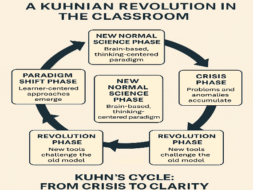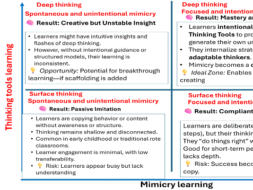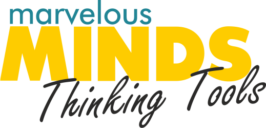In the contemporary educational landscape, the one-dimensional transmission of knowledge no longer holds relevance. The emphasis shifted from content learning to acquiring learning skills. The solution does not lie in the logistics of where and when children learn, as seen in flipped classrooms where students must study lesson content beforehand. Nor does the solution lie in technology. Since learning processes are driven by the brain, the solution must also be sought within the brain.
Years of learner-centered learning experiences have led to the recognition of a manageable, holistic, integrated thinking tool that is now described for the first time. It is a widely accepted fact among educators, based on Benjamin Bloom's (1956) insights, that the brain can think analytically, synthetically, and evaluatively.
All exams must reflect elements of Bloom's Taxonomy in a specific ratio to meet moderation requirements. Similarly, different levels of thinking dimensions in the brain exist, like Bloom’s Taxonomy, that are not alien to life but merely a description of natural brain processes. We are constantly analyzing, synthesizing, and evaluating throughout the day.
An analogy to understand thinking dimensions is to consider how a mother organizes a child's birthday party. On the macro level, she must consider the child's age, the time of year, the guest list, gifts, and themes influenced by the child’s age and preferences. These aspects affect all subsequent decisions, illustrating the clear relationships between thinking dimensions. The outcome of each aspect is a decision. How these decisions are executed depends on the mother’s personality, whether she is more laissez-faire or a control-oriented person.
Meso-level thinking flows from macro-level thinking, such as choosing a venue, activities, refreshments that match the theme and age, and the format and scheduling of invitations. These decisions influence her micro-level thinking, including planning and procuring decorations, catering, and goodie bags for guests, as well as the chronological planning of the day and the party. Micro-level thinking completes the planning phase. Nano-level thinking occurs during the practical preparation, involving decisions about placement, checking if every guest has a goodie bag, and ensuring the venue’s lighting is appropriate. This continues until the removal of activity elements.
Pico-level thinking happens when the first guests arrive and the mother, following her meso-level planning, groups or does not group certain parents and engages the children in activities. She does this according to her personality, either laissez-faire or control-oriented. Pico-level thinking is automatic atomic thinking in response to events and crisis management. Her reactions are usually predictable given the nature of her dimensional thinking. For example, whether she sees a spilled drink on her new tablecloth as a minor issue or a crisis.
Each thinking dimension incorporates elements of the others within that specific level to create a dynamic learning experience, making the mother ‘smarter’ when planning the next party. The reason she can work ‘smarter’ in the future is due to the formation of new neural pathways at different dimensional levels, which are usually stored in long-term memory.
Information contained in neural pathways is hard to forget. For instance, trying to forget your worst life experience is nearly impossible. On a broader scale, it seems as if successful people take more control of this macro/pico thinking model and manage it proactively, while less successful people tend to reactively respond on an ex post facto basis.
They wait for an accident to happen before doing what should have already been done.
People, and by implication learners, have the ability to decide at which level they want to focus at a specific time and which levels to park temporarily.
What Does This Have to Do with Education?
To clarify, I primarily use mathematics, a long-standing focal point, and focus on the curriculum as a generic description. For each child, such a dimensional thinking model can be established to address specific learning gaps and problems at each thinking level, which influence and are influenced by other levels.
Macro-level thinking focuses on the bigger picture of a subject, empowering learners to understand broad concepts, such as how algebra, geometry, and trigonometry support each other. The same applies to language studies, where prose and poetry are part of language learning, and ecosystems in biology.
Neural pathways built through macro-level thinking can be compared to a national highway system (N-roads). Meso-level thinking can be compared to secondary neural routes (R-roads). Micro-level thinking would then be the urban network roads in the brain, nano the street network to your house, and pico very personal, like the path to your front door and the movement spaces in your house.
Meso-level thinking can focus on specific areas like algebra, geometry, or trigonometry. In history, for example, it can focus on different world wars, each including preceding macro, micro, nano, and pico elements.
Micro-level thinking focuses on lesson topics, such as reading time on a clock and calculating the passage of time. These topics rely on learners' thinking processes at the macro level, dealing with the seasons of the year and related concepts, while meso-level thinking involves activities manifested throughout a day or week.
Nano-level thinking focuses on fundamental neural processes where learners perform activities such as solving a math problem, understanding blood flow through the heart, making a series of journal entries in accounting, or analyzing a poem. The result of nano-thinking largely involves pattern discovery. When learners discover the pattern in factorization themselves, the nut is cracked, as all expressions must be factorized according to the pattern.
Pico-level thinking represents lightning-fast atomic automatism. It requires that the learner's nano, micro, meso, and macro thinking dimensions are sufficiently in place.
In practice, this means a learner looking at a poem can immediately identify the type of language representation without going through complex thinking, and at the same time, recognize rhythm and rhyme patterns, imagery, and tone, as visible through structure and visual layout. Similarly, a Grade 10 learner looking at the linear equation y=3x+5 should instantly recognize that it is part of number patterns at the meso level, that the 3 indicates a pattern related to counting by 3s as covered in Grade 1, and that 5 is the initial term in a linear pattern sequence, indicating the y-intercept of the graph. Additionally, all y-coordinates will be multiples of 3. This makes understanding linear graphs as easy as falling off a log.
Such learners have the confidence that they are mentally fit to consciously seek solutions or insights at the nano, micro, meso, and macro levels. Only then can we talk about problem-based learning.





